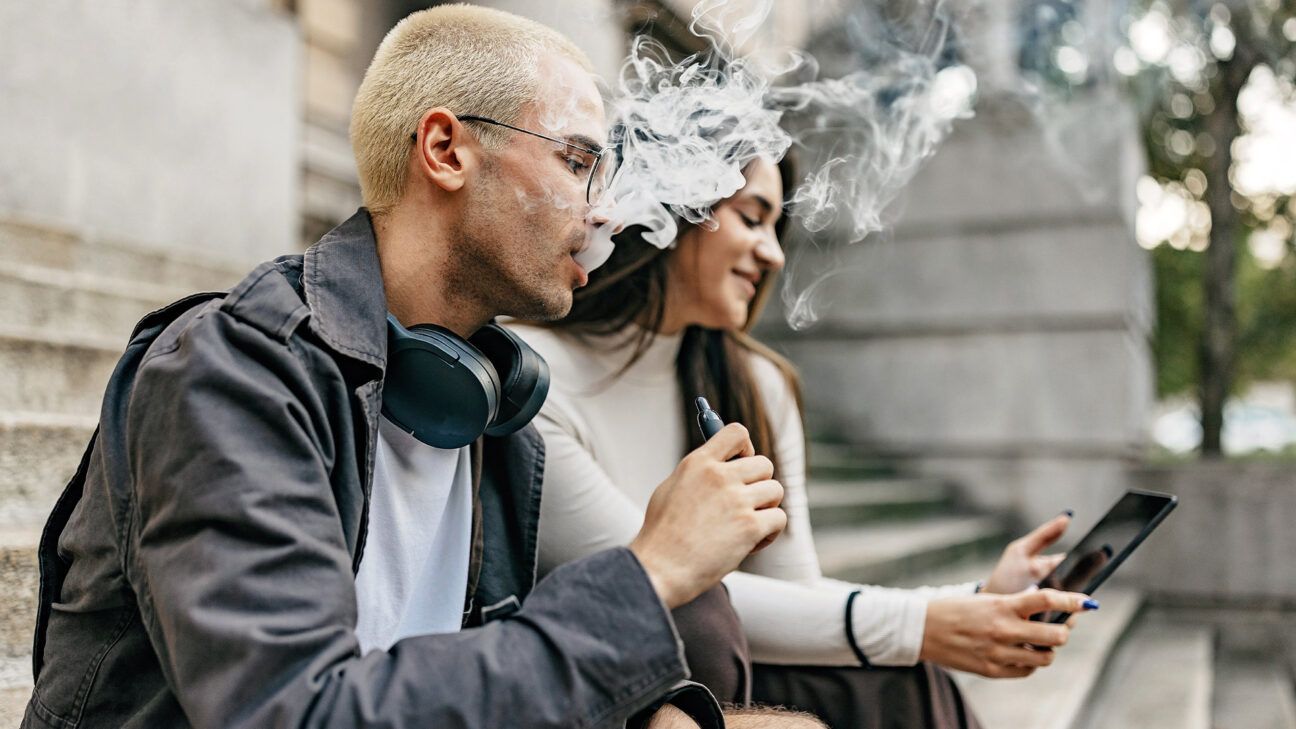
- Smoking rates in the U.S. are declining overall, but vaping remains more popular than ever, especially among young people.
- A new study found nearly half of young adults successfully quit vaping at 3 months with a quitline-based intervention.
- Overall, quit rates were higher than expected based on previous studies on smoking cessation among young adults, researchers say.
- The quitline intervention that included nicotine replacement therapy (NRT) seemed most promising for quitting vaping. This is the first randomized trial testing NRT for vaping cessation.
- Participants also reported satisfaction with coaching calls, which researchers say likely contributed to the higher-than-expected quit rates.
Quitlines are free telephone services for people who smoke and use tobacco that provide support to help them quit.
In the United States, more than 10 million people have reached out to a quitline to help them quit smoking, a promising intervention for successful smoking cessation, according to the Centers for Disease Control and Prevention (CDC).
Research on the effectiveness of quitlines has grown in recent decades.
Now, a new study from the RVO Health Center for Wellbeing Research found that a quitline-based intervention successfully helped young adults quit vaping. E-cigarettes are the most commonly used tobacco product among young people.
The research, funded by the American Heart Association, was published in the American Journal of Preventative Medicine on December 11.
The quitline intervention used in this study provided all participants with some form of treatment. The intervention yielded higher-than-expected quit rates, with nearly half (45%) of participants abstinent after three months. It’s the first large randomized trial examining the impact of a quitline-based intervention with nicotine replacement therapy (NRT).
“These findings suggest that NRT is a promising intervention and needs further examination in future research trials,” said Katrina Vickerman, PhD, director of the Center for Wellbeing Research at RVO Health, a health information and services company that includes platforms like Healthline.
“We were excited to see the success of young adults in this study with overcoming their addiction to the high levels of nicotine that many vaping devices can deliver,” Vickerman said.
Quitline intervention led to successful vaping cessation
While overall smoking rates in the U.S. have declined in recent years, vaping continues to be popular, especially among young people. In 2018, former U.S. Surgeon General Jerome M. Adams, MD, declared a vaping epidemic among youth and young adults.
The long-term effects of vaping are not fully understood, but emerging evidence cites cardiovascular disease and chronic obstructive pulmonary disease (COPD) as possible health risks.
Despite the prevalence of vaping and its possible consequences for human health, only a handful of large studies have tested effective vaping cessation strategies.
“When we initiated this study, there were no published vaping cessation trials to base our estimates on,” Vickerman told Healthline.
“Smoking cessation interventions for youth and young adults have historically achieved lower quit rates in randomized trials, which may reflect challenges engaging these groups in treatment studies. In this study, we provided everyone with treatment,” she explained.
“At the time we designed this study, there was very little information about dosing NRT for individuals who vape. We wanted everyone to speak to a quitline coach to allow for an assessment of their nicotine addiction, NRT dosing for those randomized to receive NRT through the study, and education on why and how to use NRT,” she said.
For the study, Vickerman and co-leader Liz Klein, PhD, MPH of The Ohio State University College of Public Health, examined the effects of a two-call coaching protocol, mailed NRT, and a mobile health “mHealth” technology program. The mHealth program was delivered via text message and included links to quit resources like videos, podcasts, and online education content. The control group was a two-call coaching program only.
From July 2021 through September 2022, researchers recruited young adults in the U.S. ages 18–24 who exclusively used e-cigarettes through ads on Facebook, Instagram, and social websites like Reddit.
A total of 981 participants were eligible and randomized into four groups with a 2×2 design. After completing the first coaching call, 508 were fully enrolled. Participants who were enrolled vaped regularly, which researchers defined as 20 or more days in the last month.
The four groups were broken down as follows:
- coaching calls (with no NRT or mHealth)
- coaching calls with mHealth (no NRT)
- coaching calls with NRT (no mHealth)
- coaching calls with mHealth and NRT
The coaching calls were an important part of the study intervention. Vickerman said they follow quitline intervention protocols, which are based on social cognitive theory and current clinical practice guidelines for tobacco cessation.
The calls begin with a series of questions to understand a person’s tobacco use history, triggers for use, barriers to quitting, and strengths that can help with quitting. Vickerman noted the impact of these calls exceeded the researchers’ expectations.
George Chaux, MD, board certified interventional pulmonologist and medical director of Interventional Pulmonary at Providence Saint John’s Health Center in Santa Monica, told Healthline he found the effectiveness of the coaching calls as the control intervention compelling. Chaux wasn’t involved in the study.
“This study, although limited, suggests that coaching calls are sufficient alone,” Chaux told Healthline, adding that combined forms of NRT may be even more effective for vaping cessation.
Why are quitlines so effective?
Quitlines are confidential services that offer guidance, counseling, and self-help resources, with some providing free medications like NRT.
They are available in every state in the U.S. and have the infrastructure to provide large-scale, effective, and cost-effective interventions for smoking cessation.
“[Quitlines] are effective in people who are motivated to quit smoking or vaping and simply need support to overcome the cravings of nicotine,” Chaux said.
Vickerman noted that young adults in the study seemed more aware of NRT and more open to using it than anticipated.
“In fact, 28% reported previous use of NRT before the start of the study, and a quarter of participants who were not provided NRT in the study sought out NRT on their own,” she said.
While the 7% improvement in quit rates with mailed NRT was not statistically significant, Vickerman said the findings suggest that NRT is a promising intervention and needs further examination in larger trials.
“Our study was underpowered to detect a difference of this size; this would be a clinically important difference if it held up in a future, larger study,” she said.
“Given that NRT appeared to be safe (with no unusual side effects) and acceptable for young adults in this study, we would feel comfortable dosing and mailing NRT without coach interaction in future studies. The mHealth intervention had a smaller effect but still warrants further investigation in future trials as mHealth interventions are easily scalable and can reach more individuals in need of help at a lower cost,” she continued.
Vickerman added they would like to better understand which components of the quitline-based intervention are most effective for helping young adults successfully quit.
“It may be that all of the intervention components are not needed, or that one component, like mHealth, is more successful in reaching and engaging participants, but some individuals who vape may need a higher level of support to be successful, like one-on-one coaching,” Vickerman said.
“Understanding the impact of the individual components can inform how best to use public health resources and offer vaping cessation interventions through state quitlines. In future trials, we plan to expand who is eligible to individuals who both vape and use other tobacco products,” she concluded.
Resources to help you quit
Quitlines like 1-800-QUIT-NOW can help you quit smoking and vaping for good. Other quit resources include:
Takeaway
Vaping is widespread among young people despite the possible health risks.
A new randomized trial used a quitline-based intervention to help young adults quit smoking and found nearly half of the participants successfully abstained at 3 months.
Researchers were surprised by higher-than-expected quit rates and how well the coaching calls resonated with the young adult participants who often prefer digital engagement.
The quitline intervention that included nicotine replacement therapy (NRT) seemed most promising for vaping cessation.
Quitlines are free resources available in every state in the U.S., offering support and medications like NRT to help you quit for good. For more information, call 1-800-QUIT-NOW or visit Live Vape Free.
RVO Health provides tobacco cessation services and is a vendor for numerous state quitlines in the U.S.

